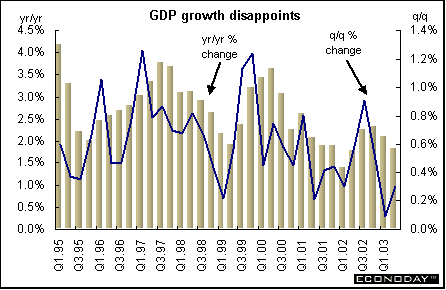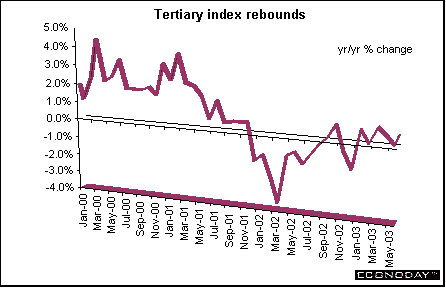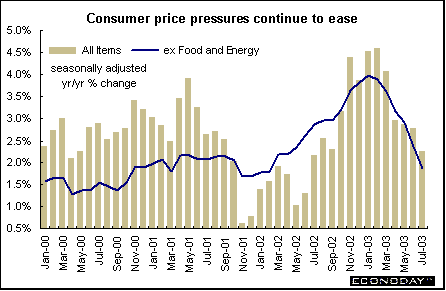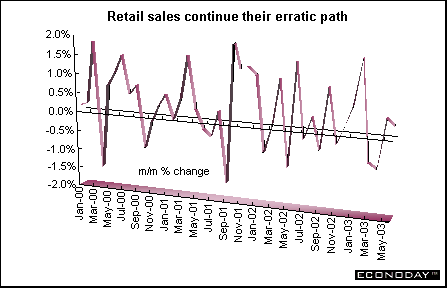
Indicator scoreboard
EMU — June seasonally and workday adjusted industrial output fell 0.1 percent and 1.6 percent when compared with last year. Output in member countries was down with the exception of Spain and Greece. Only capital goods output declined on the month.

July harmonized index of consumer prices dipped 0.2 percent but climbed 1.9 percent when compared with last year. The monthly decline was attributed to lower clothing and food prices. The core HICP, which excludes energy, food, alcohol and tobacco, slipped 0.2 percent but was up 1.6 percent on the year. Five member countries had inflation above the ECB's 2 percent inflation ceiling and five were below. Dutch data for the period June 2002 to June 2000 are in the process of being revised due to errors in the processing of scanner data for supermarket products. Statistics Netherlands said that a downwards correction to the Dutch all items HICP index is likely and that, according to early indications, the correction may have accumulated to a few tenths of a percentage point by the end of the period. The impact on the eurozone is expected to be relatively small.

June merchandise trade surplus with the rest of the world was €5.4 billion, down from a surplus of €10.3 in June 2002. The data suggest that the euro's appreciation and weak world growth this year triggered the decline. Exports were down 5 percent while imports were unchanged on the year.

Germany — August ZEW economic expectations index jumped to 52.5 from July's reading of 41.9. This was the eighth straight month that the index, which reflects the economic outlook for Germany among German financial experts, was up. The ZEW surveyed 310 German financial experts from July 28 to August 18 for their opinions on current economic conditions and the economic outlook for major industrial economies.
July producer prices were up 0.3 percent and 1.9 percent when compared with last year. Energy prices rose 1.3 percent and 7.7 percent on the year. Excluding energy prices, the PPI was down 0.1 percent but managed to climb 0.3 percent on the year. The PPI for semi-finished goods excluding energy slipped by 0.1 percent but inched up 0.1 percent on the year.

June seasonally and workday adjusted manufacturing orders were revised to 2.4 percent, up from the originally reported 2.3 percent. Foreign orders were revised to an increase of 6.0 percent from the originally reported 5.7 percent. Domestic orders were unrevised at a decline of 0.5 percent.

Second quarter seasonally adjusted gross domestic product was down 0.1 percent and 0.2 percent when compared with the second quarter of last year. This was the third straight quarter that GDP has declined. Exports sank 2.3 percent after dropping 0.3 percent in the first quarter. Imports were down 1.1 percent after climbing 1.5 percent in the first quarter. Second quarter exports were negatively affected by strikes in east Germany along with the rising value of the euro. Domestic demand, up only 0.4 percent for the second quarter in a row, did little to offset weak foreign demand.

France — June seasonally adjusted merchandise trade deficit was €90 million, as imports outpaced exports. In May, the merchandise trade surplus was €379 million. Exports climbed 1.7 percent after a 5.7 percent plunge in May when sales were limited by a number of long holidays and by transportation strikes. Imports bounced back 3.7 percent after a 6.4 percent drop in May.
Second quarter gross domestic product dropped 0.3 percent and was unchanged when compared with the second quarter of last year. A combination of falling private consumption and investment and a drop of exports contributed to the decline. First quarter growth was revised down to 0.2 percent from the originally reported 0.3 percent.

Britain — July retail sales volumes dropped 0.4 percent but were 4.4 percent higher when compared with last year. All categories were down with the exception of household goods.

Second quarter gross domestic product climbed 0.3 percent and 1.8 percent when compared with last year. Household spending increased by 1.3 percent - its fastest rate since the second quarter of 2001. Government spending, which rose 1.1 percent on the quarter, also helped push growth up. Service sector output was up 0.3 percent while production industries inched up 0.1 percent, as did manufacturing.

Asia
Japan — June tertiary activity index which measures business at retailers, utilities and other service companies, was up by 1.2 percent and 2.0 percent when compared with last year. The broader all-industry index rose 0.9 percent and 1.9 percent on the year. The all industry index takes a reading of activity in the six industries that comprise the tertiary index combined with activity in the construction, agricultural and fisheries industries, the public sector and industrial output. This index is considered a close approximation for gross domestic product growth as measured by industrial and service sector output.

Americas
Canada — July consumer price index inched up 0.1 percent and was up 2.2 percent when compared with last year. Core CPI, which excludes food and energy, also was up 0.1 percent and 2.2 percent on the year. The Bank of Canada core rate, which excludes eight of the most volatile components of the index, was unchanged on the month and up 1.8 percent on the year. Energy prices rose by 0.4 percent in the month and 6.7 percent on the year, while food prices were unchanged in July and up 1.9 percent on the year. Upward pressure on the CPI came mainly from increases in natural gas, fuel oil, gasoline and air transportation costs, while downward pressures were mainly due to drops in the prices of beef and electricity. Many of the sub-indexes were not available because of delays in compiling the figures following last Thursday's blackout. Statistics Canada, like most Canadian government departments, is running reduced services for at least the rest of this week.

June retail sales rose by 0.3 percent after climbing 0.5 percent in the previous month. All sectors were up with the exception of the automotive sector where sales declined 1.1 percent. In constant dollars, retail sales rose 0.5 percent following a 0.7 percent advance in May. When compared with last year, retail sales were up 2.7 percent.



Last Week's Highlights • Global
Stock Market Indexes • Recap of Global Markets
• Currencies • Indicator
Scoreboard

The Bottom Line •
Looking Ahead
|